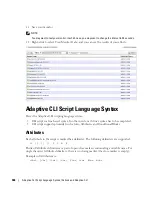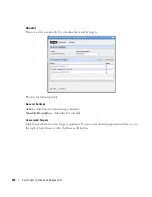
| Glossary
379
and a self-signed certificate does not provide any guarantee concerning the identity of the
organization that is providing the website.
SMTP —
Simple Mail Transfer Protocol.
SNMP —
Simple Network Management Protocol. Network management protocol used
almost exclusively in TCP/IP networks. SNMP provides the means to monitor and control
network devices, and to manage configurations, statistics collection, performance, and secu-
rity.
S
PANNING
T
REE
P
ROTOCOL
(STP) —
The inactivation of links between networks so that infor-
mation packets are channeled along one route and will not search endlessly for a destina-
tion.
SSH (S
ECURE
S
HELL
) —
A protocol which permits secure remote access over a network from
one computer to another. SSH negotiates and establishes an encrypted connection between
an SSH client and an SSH server.
SSL (S
ECURE
S
OCKETS
L
AYER
) —
A program layer created by Netscape for managing the
security of message transmissions in a network. Netscape's idea is that the programming for
keeping your messages confidential ought to be contained in a program layer between an
application (such as your Web browser or HTTP) and the Internet's TCP/IP layers. The
“sockets” part of the term refers to the sockets method of passing data back and forth
between a client and a server program in a network or between program layers in the same
computer.
T
RAP
(SNMP T
RAP
) —
A notification from a network element or device of its status, such as a
server startup. This notification is sent by an SNMP agent to a Network Management Sys-
tem (NMS) where it is translated into an event by the Mediation Agent.
T
RAP
F
ORWARDING
—
The process of re-emitting trap events to remote hosts. Trap Forward-
ing is available from the application through Actions and through the Resource Manager.
VLAN —
A virtual local area network (LAN), commonly known as a VLAN, is a group of
hosts with a common set of requirements that communicate as if they were attached to the
Broadcast domain, regardless of their physical location. A VLAN has the same attributes as
a physical LAN, but it allows for end stations to be grouped together even if they are not
located on the same network switch. Network reconfiguration can be done through software
instead of physically relocating devices.
Содержание OpenManage Network Manager
Страница 1: ...Dell OpenManage Network Manager version 5 1 Web Client Guide ...
Страница 14: ...14 A Note About Performance Preface ...
Страница 98: ...98 Schedules Portal Conventions ...
Страница 141: ...Vendors Key Portlets 141 Vendors Snap Panel The snap panel displays the icon for the selected vendor ...
Страница 142: ...142 Vendors Key Portlets ...
Страница 232: ...232 File Management File Servers ...
Страница 242: ...242 Deploy Configuration ...
Страница 290: ...290 Key Metric Editor Monitoring Metrics This panel s display depends on the selected device ...
Страница 340: ...340 ...
Страница 374: ...374 Adaptive CLI Records Archiving Policy Actions and Adaptive CLI ...
Страница 380: ...380 Glossary ...
Страница 388: ...388 388 Index ...










































